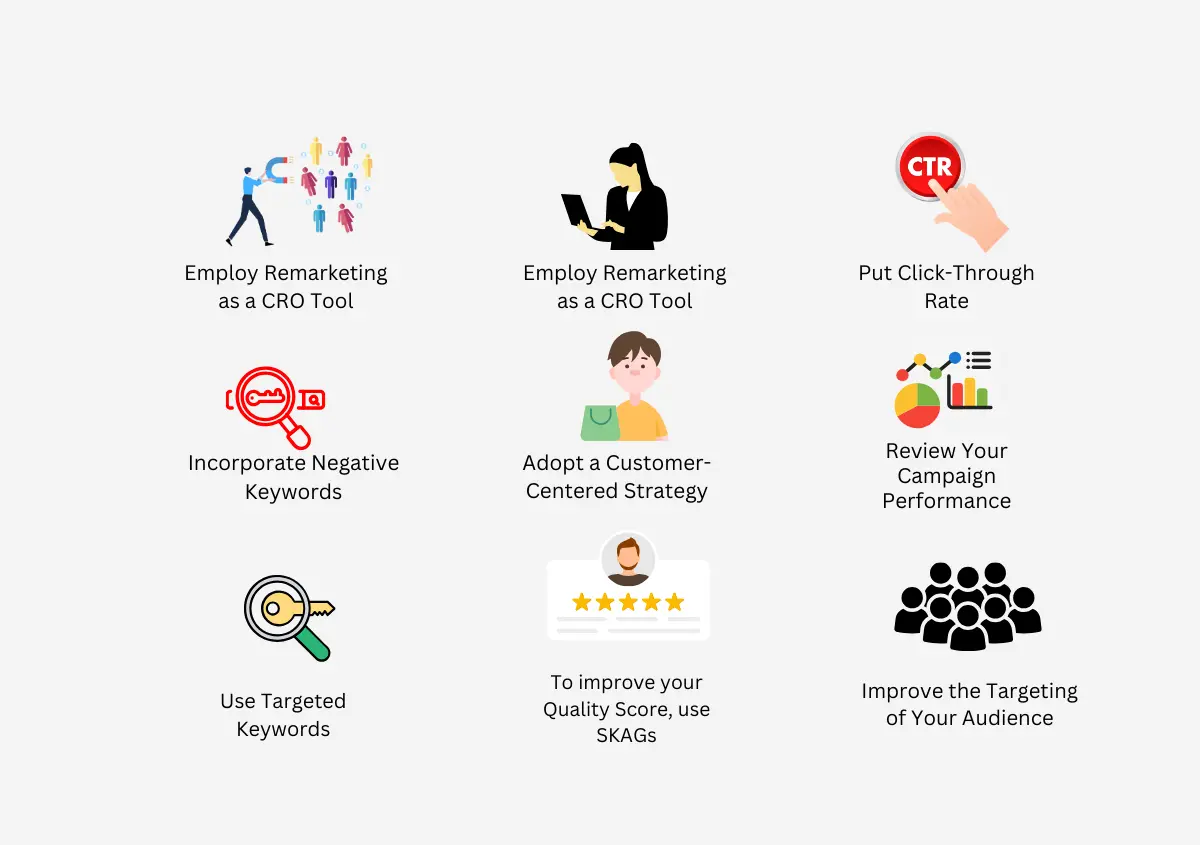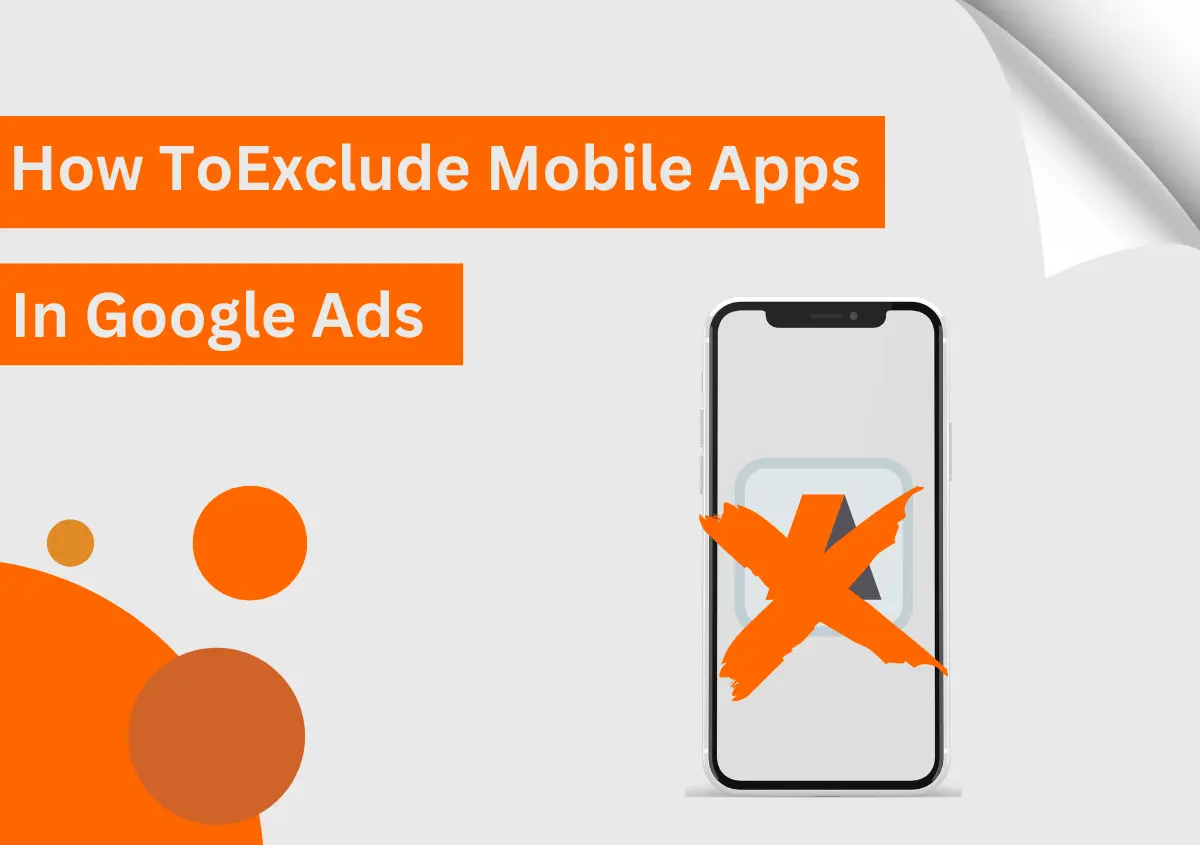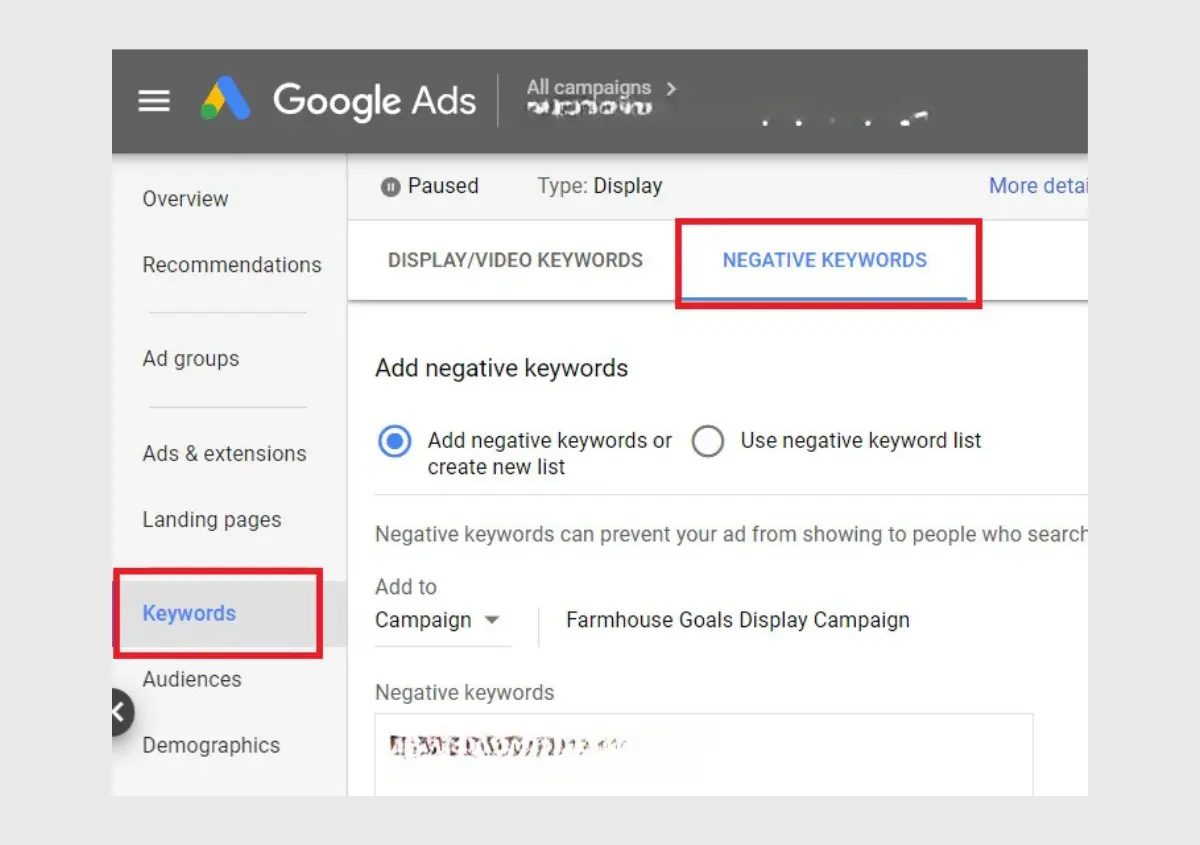Every business wants a twofold increase in their PPC conversions from Google Ads.
A majority of astute Google Ads marketers worry about two things only—boosting conversion rate and lowering the conversion cost. Besides these, everything else comes second. And for a marketer, nothing else really counts unless these goals are achieved.
You’ll need to understand technical terms like conversion ID, conversion pixel, and conversion code to keep track of things.
It’s understood that Google Ads can be scary because you’re afraid of losing money. However, it’s still widely used because it provides the highest conversion rates and ROI on the main marketing KPIs. The conversion rate is a critical success factor of your campaign. You must understand why it drops and how to correct it to make it rise.
So, let’s get started.
What is the Conversion Rate?
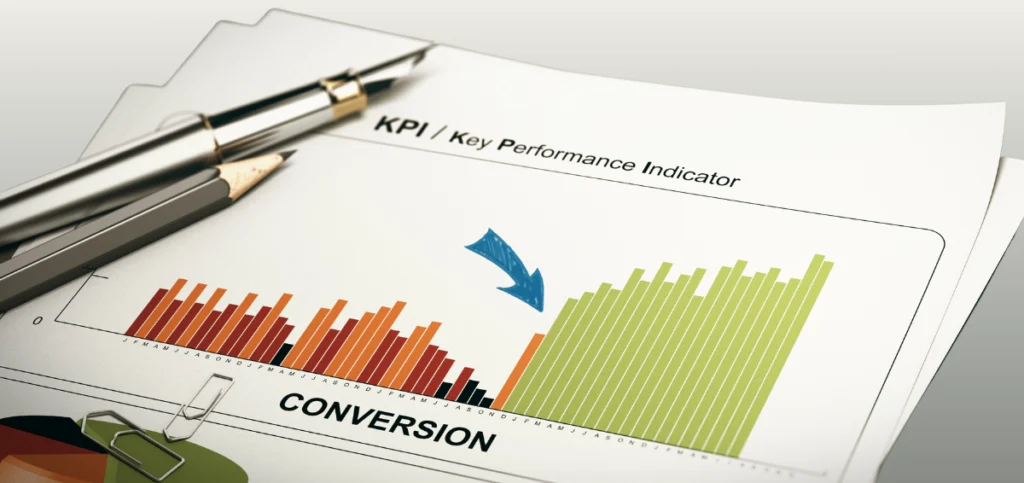
Conversion rate is the percentage of users who click on your ad and then “convert” or take an action such as submitting a form, making a purchase, etc. Compared to other ”surface-level metrics,” conversion rate is unique because it encompasses ad copy quality, search query intent, and landing page quality.
The regular conversion rate is the percentage of visitors to your website who complete the desired CTA from the total number of visitors. The Google Ads conversion rate is the number of conversions of your Google Ads, but in percentage format.
Reasons for Google Ads’ Low Conversion Rate
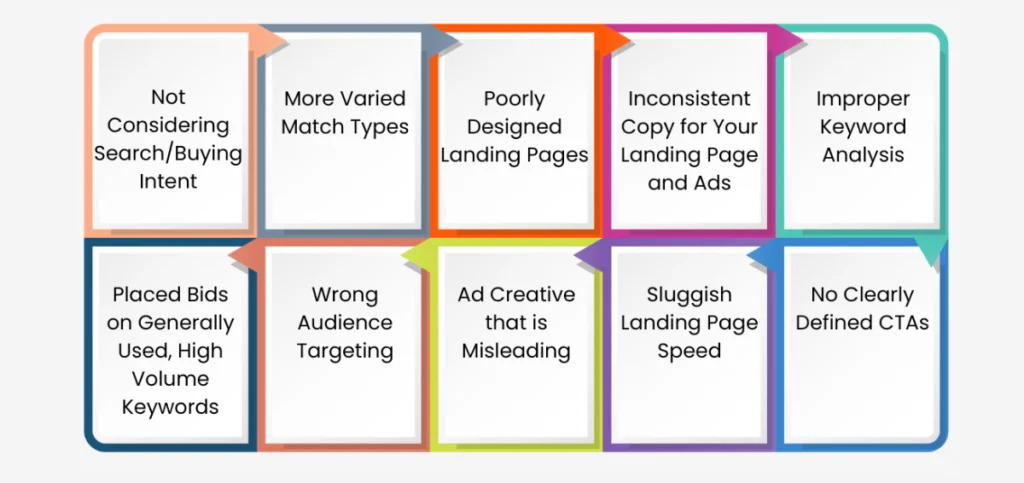
While many focus solely on the landing page aspect of conversion rate (CVR), we believe it’s the interplay between purpose, advertisement, and destination that truly impacts CVR.
A strong advertisement may not salvage a subpar landing page, and despite a well-crafted ad, weak search intent can also affect CVR.
Crafting an appealing ad that attracts clicks but fails to generate qualified leads or sales can be frustrating. Nearly 90% of PPC experts have experienced this situation.
So, why is there a high click-through rate (CTR) but a low conversion rate?
According to data from the Google Ads Benchmarks Group, the median Google Ads Conversion value for August 2023 was 55.
How does your business measure up?
The pandemic’s disruptions likely brought down CVR. But what else might have caused this to happen?
1. Not Considering Search/Buying Intent
This seems to be a search mistake and the other concerns the user intent. This implies that customers who have clicked on your ad and landed on your website are unable to find what they are searching for.
Another might be the online experience itself, which makes your visitors bounce back. Thus, you, for example, do not have an opportunity to purchase something without registering, or the website’s navigation is awkward.
Some Tips
- Before launching an ad campaign, double-check that the landing page link for the advertised product or offering is accurately presented in your ads.
- Make sure you have the commodity advertised in stock.
- Ensure your customers enjoy a simple website experience. Can they navigate it easily and find what they need? How many steps are necessary to make a purchase? How can I make it simpler?
2. More Varied Match Types
Google’s 2021 spectrum of match types expanding occurrence has triggered multiple debates about its consequences. While it was intended to simplify advertising by turning a blind eye to it, people find it eternally annoying. The problem is that more match types basically approach losing the ability to control search phrases. Hence, the life of account managers who solely run SKAGs is almost compromised as they forever have to append negatives. That said, this occurrence raises the question of when the automation become unbeatable to manage Google Ads.
3. Poorly Designed Landing Pages
The most common mistake that results in low conversion rates is the landing page. God knows why you keep the user on a landing page that doesn’t match the ad, but it helps you get higher CTR and lower conversion rates. There is a way out of this muddle.
The first is to create an audience-centric landing page. The second is to ensure that it is simple, clean, and easy to navigate. The page speed is crucial. Ensure that the page can work on any type of mobile device. Next, make sure that the conversion funnel is as natural as possible when the customer has something to gain with the conversion. Also, it would help if you made an analysis of the competition’s landing pages to make a better choice. Moreover, you could you equipment optimization tools to improve the conversion rates. Finally, track the statistics to determine the conversion goals.
4. Inconsistent Copy for Your Landing Page and Ads
Weak landing page copy is just as important to low conversion rates as bad landing page UX, especially when the ad content is inconsistent with the landing page copy.
When an ad campaign has a high CTR but no conversions, there are two main causes. 1) You are ranking on an incorrect CTA. 2) The copy on your landing page and ad copy are completely different.
Every aspect that might benefit your campaign to increase the conversion rate must be considered. Make sure your website page loads quickly and is Mobile Responsive. Avoid misleading your audience with misleading marketing taglines and false expectations. Prospects should be taken to the right page when they click on your ad.
Therefore, if you have a great ad, but the landing page is not what the user was expecting – quickly fix it!
5. Improper Keyword Analysis
Some people may have noticed mistakes in their Google Ads campaigns, which can result in high CTRs but dreadful conversion rates (or worse, unqualified or irrelevant clicks). It is because the keyword insertion token matches with irrelevant search phrases overbroad or phrase match keywords.
For example, a dynamically created ad for “women’s boots” might appear for a search like “women’s leather boot repair.” The user would click on it without even looking at the landing page–it means you’ve just paid for an unqualified click.
Another mistake might be bidding on your competitor’s branded keywords, where capturing that traffic might make sense at first; however, users searching for specific branded terms may or may not convert. For instance, ranking for the “Vanity Fair” brand name might accrue some clicks if the user is uncertain of what they are looking for, but if the user is certain, they may not convert. You might have a false sense of gaining traffic but no actual conversions.
6. Placed Bids on Generally Used, High Volume Keywords
Although the possible impact of high search volume behind keywords for bidding is tempting, it has certain risks.
One of the common mistakes in bidding on paid search is overbidding for general keywords. Such keywords generate many clicks but are often not fully synchronized with the user’s landing page expectations, leading to a low conversion rate.
The best approach would be using long-tail keywords that reflect the search intent, which leads to a higher conversion rate despite lower CTR. Prior to running a sponsored campaign, a keyword search is a must. The emphasis should be put on looking to show up for the relevant searches rather than seeking a high search volume of your paid search.
7. Wrong Audience Targeting
A low conversion rate and a high CTR suggest that either your website needs updating or your ad is targeting the incorrect customers. If your landing page and copy are excellent, responsive, and compliant with industry standards, the reason probably lies with a mistargeted ad. Make sure you keep your Google negative keyword list up-to-date to avoid ranking for similar competitor products that you don’t really offer. You want to use carefully chosen keywords to filter out customers who aren’t interested in your offering.
8. Ad Creative that is Misleading
At times, PPC professionals may lose their heads in creativity and prepare visually attractive, although accidentally misleading, ads. It is not rare for a situation where ads have a great CTR but zero conversion rate. The most common reason found was creative errors.
Let’s say an ad’s creative is excellent but does not resonate with the interests of the target audience. As a result, people click the call-to-action without seeing any benefit in the offer, and conversions are not generated. When you replace the ad’s image with an ad with relevant copy, the CTR would increase significantly without any changes needed.
9. Sluggish Landing Page Speed
A poor site experience combined with a slow loading time is unlikely to convert prospects. Furthermore, a poor navigation flow can lead to unqualified clicks, inflating the number of ad clicks without reaching the click-to-convert point. If you notice an increasing CTR with zero conversion, the landing page design alone should not be blamed. Technical problems, such as input lag or website speed, are also important issues. Large font size also impacts the mobile experience and slows down website responsiveness. A site performance analysis, including bounce rates and page performance, will give insights into these issues.
10. No Clearly Defined CTAs
If your landing page has high CTR but low conversion rates, the center of the problem is likely the CTAs. Although a high CTR implies interest from the user side, low conversion rates mean they aren’t encouraged to take action.
To address this issue, add CTAs like “Buy Now” or “Read More.” However, make sure they don’t get overlooked or lost in the surrounding content. Although the CTA button shouldn’t be extremely large, it should grab attention. Avoid CTAs that are too soft or lack contrast with the surroundings. We would recommend mixing text, colors, graphics, and positions and testing them to find the best combination for your business. The A/B test option will help better understand the visitor’s behavior and find the most effective CTA type and placement.
That said, the most common reasons why a campaign might have high CTRs are:
- There is a discrepancy between the ad copy and the landing page.
- The terms that were used were broad.
- The right keywords are not being ranked for ads.
How to Improve Google Ads Conversion Rate?
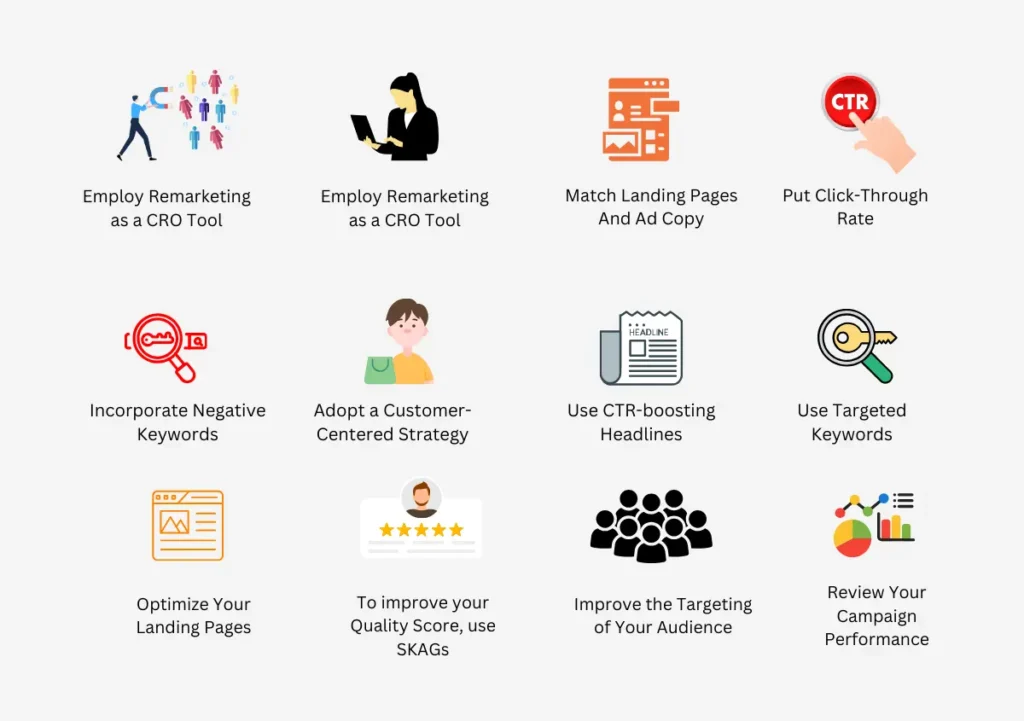
1. First, Reverse-Engineer the Acquisition Path
Instead of being excited with the results in the first place, one should understand and learn strategies. These include customer demands in the ever-changing online space.
Once you learn how to generate an email subscriber list quickly, it is manageable in any industry. An advertiser should understand the types of conversions they get through Google Ads to optimize them strategically.
One must reverse-engineer the purchase paths and services to offer keywords and ad text to landing pages that will align better for conversion.
The other aspect is understanding the buying cycle of a customer as it will enable you to guide a target audience through the purchasing process. Showing benefits and discounts to them all the time will not be as effective since they are unfamiliar with your products. Therefore, one must use several tools such as FAQs, webinars, and trials to entice a potential prospect.
Using Google Analytics can help you understand the needs and correct strategies based on consumer behavior. Another strategy is segmenting an email list and sending personal emails that contain conversion IDs can drastically increase conversion within the directive of marketing through the funnel.
2. Employ Remarketing as a CRO Tool
Remarketing is an effective method to enhance your conversion rates and re-engage individuals who previously expressed an interest in your website.
It would be possible to accomplish your goals by investing in a good conversion tracking system. Most PPC marketers ignore the strategy of remarketing. However, this ends up being an essential tool that saves valuable time and costs.
The majority of users are not likely to convert initially; as a result, you want to display your ads to them repeatedly. In addition, the more often you take advantage of retargeting, the higher your conversion rates will be, considering that you are focusing on people who are already your potential clients.
Thus, a conversion tracking system is a solution that uses conversion code embedded in clicks to collect information about a user’s action on your website. Moreover, a conversion identifier, such as a promo code, can help determine which ad was clicked on.
3. Match Landing Pages And Ad Copy
Make sure to maximize your click-through rates by appropriately aligning your landing page content with your Google ad copy. This will significantly increase your quality score, including changes in ad positioning, cost, and Google Ads conversions. The ad copy and landing page content should have a consistent path to conversion. Moreover, the alignment also applies to user optimization, which is the search funnel closely related to the quality score.
4. Put Click-Through Rate Best Practices Into Play
Google defines click-through rate as how often people who view ads click on them. Increasing your Google ads conversion rate is much more important than merely running more ads. If you want to create moving and effective ad text that resonates with your target audiences, you must distinguish between Google search ads and the display network.
The search network displays text-based ads on search engine results pages. Image-based ads, such as banners, are shown in the display network.
These are some of the click-through rate best practices you can implement to boost revenue and reduce the cost per conversion:
- Capitalization of your title in ad copy increases CTR compared to all lowercase characters
- Target keywords based on the position of your audience in the buying cycle.
- Phrases with “commercial intent” have a higher CTR, whereas exact and phrase-match keywords have a better chance of ranking.
- A match type allows your ads to show up for terms that include the search term in the same word order.
- Broad match affects more items and is more customer-friendly, but it will almost always have a lower CTR.
- Experiment with match types to see whether an exact, phrase, or broad match increases CTR.
5. Incorporate Negative Keywords
Without negative keywords, your Google Ads campaign would be incomplete. One of the greatest frustrations associated with new campaigns is wasting money on irrelevant searches.
Negative keyword research significantly improves conversion and revenue. Negative words aren’t just for search networks; they also apply to display networks. When you add a word like “free” to your negative list, your display ad won’t show up on web pages or content containing that word. Other advantages of negative keywords are increased CTR, decreased CPCs, and increased ROI.
6. Adopt a Customer-Centered Strategy
Adding audiences to your ad groups in Google Display Network is a simple process. You ought not to go after everyone.
The first rule of content marketing is to identify your target audience and then craft content that speaks to their requirements and interests.
To be successful while running ads on Google Display Networks, you will require these things—the appropriate message on your ads, and the right audience must see them at the right time in the search funnel. This should ideally result in an increased conversion rate.
7. Use Targeted Keywords
Compared to broad terms, specific keywords frequently have a higher conversion rate. See the following terms, for instance. In your opinion, which one results in a better conversion rate?
- HP Printers
- HP Laserjet Pro MFP M126nw
Generally speaking, conversion rates are higher for more targeted keywords like “HP Laserjet Pro MFP M126nw” than for more generic keywords like “HP.” This is so because most customers who look for certain models or product numbers have already done their homework and are ready to buy.
However, remember that employing more focused keywords may result in fewer impressions. Fewer individuals might search for your keywords if they are very specialized. Finding the ideal mix between being particular enough to drive conversions and generic enough to fit what people are searching for is the tricky part.
8. Use CTR-boosting Headlines
How do you pick a novel to read each time? Although it’s said that you shouldn’t judge a book by its cover, we all do.
Why? Because our unconscious mind is influenced by initial perceptions. When you see a book with an uninteresting cover, you are probably going to turn to the next book.
Since headlines are the first thing people see in a PPC advertisement, they are one of its most important components.
In a sense, the title of the ad is its first impression.
9. Ensure You Optimize Your Landing Pages
Even after running A/B tests on your advertising and experimenting with alternative headlines, images, and even a complete rewrite, your conversion rates remain terribly low. The problem may be with your landing pages rather than your adverts.
If you can’t clinch the sale with your landing page, all the ad clicks in the world won’t assist you.
- Be clear and honest in your offer. Don’t be excessively subtle or circumspect. What can you do to assist them, and why are they here?
- Reduce visual clutter and make your buttons stand out by choosing contrasting colors to keep it simple.
- Ensure that the tone and language of your landing page correspond with that of your advertisement.
- A/B Test whether headlines, images, and even content on your landing page convert better by running a test.
10. To improve your Quality Score, use SKAGs
“Single keyword ad groups” or “SKAGs,” is when a single keyphrase is combined with a distinct set of ads resulting in the creation of highly targeted PPC campaigns.
For instance, if you sell various sportswear apparel like yoga tops, bottoms, Pilates videos, and Puma running shoes, SKAGs will ensure that only people looking up “Yoga tops” will see your ads— and not people searching for running shoes.
The quality score for your PPC ads will increase due to increased ad relevancy, which is the actual return on investment or conversion rate that will also rise.
Relevance is rewarded by Google’s Quality Score, which determines ad ranking and cost-per-click. It includes landing page quality, click-through rate, ad relevance, and overall ad performance.
Thus, SKAGs increase relevancy by aligning ads with the intent of customer search which leads to higher quality scores and better ad rank and provides more efficient PPC campaigns.
11. Improve the Targeting of Your Audience
Even if people are clicking on your advertising and visiting your landing pages, you are still not receiving any conversions. You may go back and examine the headlines from the split test again, or you might have to acknowledge that you misdiagnosed the issue.
Perhaps your campaign is doing OK; you are just focusing on the incorrect audience.
Let’s say you are a vendor of amazing bespoke skateboards. Paintings in the form of graffiti tags, all the work. The skater demographic, which consists primarily of young men and teenagers aged 16 to 28, like them. Even better, imagine that each year you sell hundreds of your amazing skateboards.
You’re not going to sell a lot of skateboards if you set up shop outside of a knitting event, isn’t that right? Your audience is the problem, not your skateboards or even your marketing plan.
Additionally, take into account Google’s custom affinity audiences, which let you target people based on their hobbies and areas of interest, such as “sports fans” or “marathon runners.”
12. Review Your Campaign Performance
To boost your advertising efforts and gain better conversion outcomes, it is crucial to review how your Google Ads campaigns are performing. Begin by analyzing key metrics—this includes the click-through rate, conversion rate, and ROAS. Ensure to continuously track performance metrics and examine the data regularly to figure out which parts outperform and underperform your expectations. Experiment with and without performance results, continue optimizing your conversion tracking, and stay up-to-date with market developments.
Final Thoughts
Using Google Ads is a powerful way to rapidly increase website traffic and attract leads. The most important parameter to follow is the conversion rate, which is influenced by several factors covered in this guide.
Advertising should be created both for the search and the display networks – each of them is intended for different purposes. If the display network is used to increase brand awareness, the search network gives a direct response.
As you can see, optimizing the PPC conversion rate is a combination of science and art that involves testing, analytics, and creativity.
If you want an expert to help with this, contact our team at Website Pandas today.

